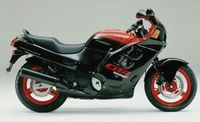After years of innovation, Honda had to acknowledge that the economic stresses of the early 1980s would force it away from the technology-first sportbikes—highlighted by jewel-like and expensive-to-build V-4s—and toward designs whose reduced manufacturing costs would allow it to be competitive. So the designers went back to the drawing board and in 1987 came up with the CBR1000F, a literbike powered by an inline-four and wrapped in slippery bodywork that teased what Honda hoped would become the next big thing—aerodynamics.
The CBR’s 998cc, 16-valve, counterbalanced engine lacked the arm-stretching pull of its contemporaries, instead offering a wide spread of power that peaked at a claimed 130 hp. It was also a homely lump, but since it was completely hidden by the bodywork it didn’t matter. Also, by eliminating the attractive finish and styling a more visible engine would demand, it cost less to make the CBR1000F. The same thinking went into the pedestrian-looking steel frame, which Honda said weighed just 4 pounds more than an aluminum one but shaved $200 off retail.
Measuring 60 inches between the axles, the CBR handled more like a sport-tourer than a sportbike, and that’s how Honda reclassified it a year and a half after it debuted as the Hurricane, a name they dropped for the 1989 model year. That same year saw the early model’s cam-chain adjuster upgraded, fairing restyled, and power increased by 5 hp. In 1992 there was another style upgrade, along with Honda’s then-new Dual Combined Brake System, a.k.a. linked brakes.
The CBR1000F has been described as the perfect choice for riders who want a 1,000cc bike but don’t want to ride it fast. That’s faint praise for a bike that does so many things so well and asks for so little in return. The CBR has shown enviable reliability over the years, with many topping 80,000 miles before showing signs of engine wear. The cam-chain tensioners on early models prompted a recall by Honda; aside from that, the CBR is known for churning along contentedly mile after mile.
The suspension, described as firm back in the day, is soft by modern standards. The front fork’s brake-activated hydraulic anti-dive is almost quaint, and the rear shock goes limp if pushed too hard. Front-tire wear is an issue with some riders who hustle the 545-pound bike hard in corners, but at a saner pace the CBR shines. Our own EIC Cook, writing in the April 1987 issue of Cycle Guide, said the engine was “smoother than a Rolls-Royce salesman” and concluded that the CBR1000F was a “thoroughly competent, astonishingly speedy motorcycle.” Even allowing for the march of progress since then, that’s still an accurate appraisal.
The dodgy cam-chain tensioner is the first thing to look for on a used bike; if it hasn’t been replaced you’ll likely hear it right off. It’s hard to hide crash damage on a bike that’s covered with plastic, but mismatched colors—either different from surrounding panels or a shiny new one next to a faded one—need to be explained.
Abundant power, stable handling, comfortable ergos, exemplary reliability.
Dated suspension cries out for an upgrade. Tire wear a problem if ridden hard.
Rattle caused by old-style cam-chain adjuster, non-functioning anti-dive that’ll need to be fixed or neutered.
A big, solid performer with do-it-all capabilities. Enjoyable, reliable, affordable.
1987 / $2,325 1988 / $2,390 1990 / $2,470 1991 / $2,535 1993 / $2,580 1994 / $2,620 1995 / $2,630 1996 / $2,655














/cloudfront-us-east-1.images.arcpublishing.com/octane/VZZXJQ6U3FESFPZCBVXKFSUG4A.jpg)
/cloudfront-us-east-1.images.arcpublishing.com/octane/QCZEPHQAMRHZPLHTDJBIJVWL3M.jpg)
/cloudfront-us-east-1.images.arcpublishing.com/octane/HXOUJXQWA5HBHGRO3EMJIGFMVI.jpg)

/cloudfront-us-east-1.images.arcpublishing.com/octane/3TIWWRV4JBBOLDVGRYECVVTA7Y.jpg)
/cloudfront-us-east-1.images.arcpublishing.com/octane/KIX5O23D5NAIBGFXBN3327DKZU.jpg)
/cloudfront-us-east-1.images.arcpublishing.com/octane/7GJYDUIPXRGMTMQKN6ONYOLBOU.jpg)
/cloudfront-us-east-1.images.arcpublishing.com/octane/MUQLOVLL2ZDGFH25ILABNBXKTI.jpg)
/cloudfront-us-east-1.images.arcpublishing.com/octane/TNOU5DNE2BC57MFPMGN2EIDXAM.jpg)
/cloudfront-us-east-1.images.arcpublishing.com/octane/GTCXACQGJ5HAPDTGWUQKDEH44E.jpg)
/cloudfront-us-east-1.images.arcpublishing.com/octane/S35YGSEMEZB4BLTDJTSZPF4GLA.jpg)
/cloudfront-us-east-1.images.arcpublishing.com/octane/5UOT6HPX2JFMRJAX6EH45AR4MQ.jpg)
/cloudfront-us-east-1.images.arcpublishing.com/octane/OKWOJWAKP5EP3OACCRRWPCIX2Q.jpg)
/cloudfront-us-east-1.images.arcpublishing.com/octane/2WF3SCE3NFBQXLDNJM7KMXA45E.jpg)
/cloudfront-us-east-1.images.arcpublishing.com/octane/G4MG6OUCJNBSHIS2MVVOTPX65E.jpg)
/cloudfront-us-east-1.images.arcpublishing.com/octane/IIGGWFOTOJGB7DB6DGBXCCMTDY.jpg)
/cloudfront-us-east-1.images.arcpublishing.com/octane/QSTCM6AVEZA5JJBUXNIQ3DSOF4.jpg)
/cloudfront-us-east-1.images.arcpublishing.com/octane/U4I7G625B5DMLF2DVIJDFZVV6M.jpg)
/cloudfront-us-east-1.images.arcpublishing.com/octane/B6XD6LS6IVCQPIU6HXDJSM3FHY.jpg)
/cloudfront-us-east-1.images.arcpublishing.com/octane/ICL63FEDDRDTTMINYICCEYGMDA.jpg)
/cloudfront-us-east-1.images.arcpublishing.com/octane/FCGZHQXRBZFLBAPC5SDIQLVF4I.jpg)
/cloudfront-us-east-1.images.arcpublishing.com/octane/WNOB6LDOIFFHJKPSVIWDYUGOPM.jpg)

/cloudfront-us-east-1.images.arcpublishing.com/octane/X33NU3E525ECRHXLNUJN2FTRKI.jpg)